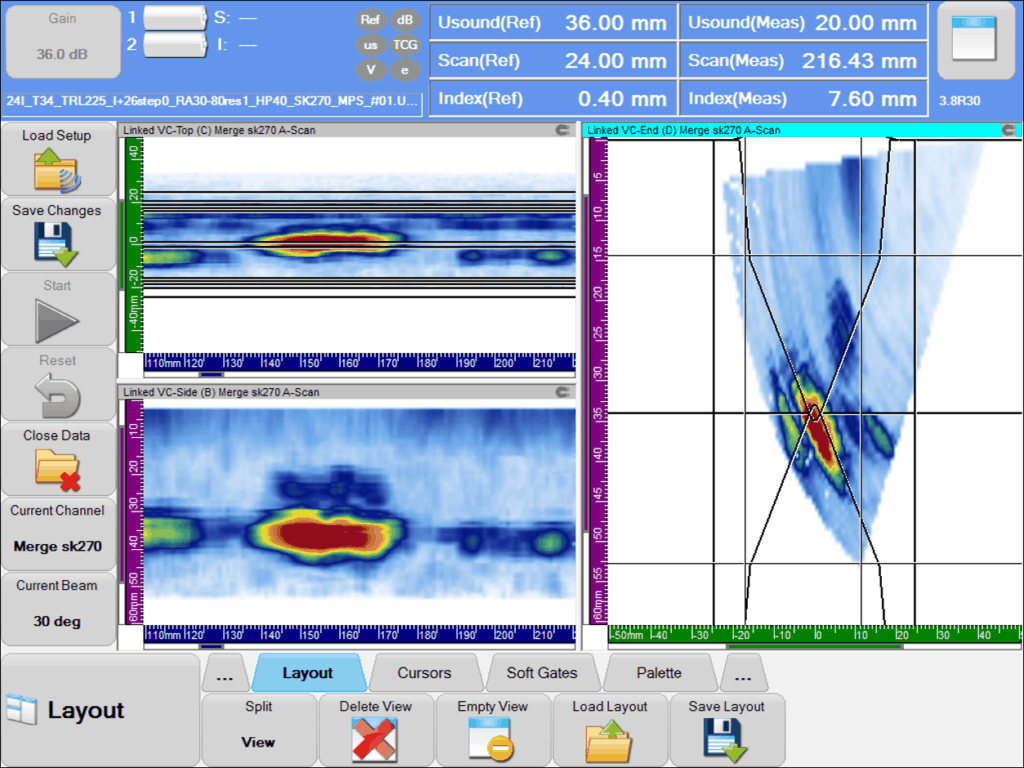Mitigate Dead Zones in Ultrasonic Testing of Austenitic Welds

Nondestructive testing of austenitic steels can prove challenging because of dead zones. These coarse metals create issues with standard ultrasonic testing, causing inspectors to miss crucial signs of potential distortion or flaws. What makes this even more challenging is how prevalent the use of this metal is across industries. As austenitic steel is both resistant to corrosion and durable, it’s a popular choice. But anyone inspecting the welds in austenitic metal will likely run into issues with dead zones in ultrasonic testing.
Coarse austenitic material can present a challenge in ultrasonic testing because it’s not as easy for sound beams to penetrate these materials. A poor travel path can result in inaccurate readings. However, this inspection is essential because austenitic steel welds have the potential to contain serious flaws. Leveraging low-frequency, 2D matrix-based UT is the best possible way to eliminate issues with dead zones and challenges of detection in these materials.
Austenitic Steel Weld Composition
When discussing austenitic steel welds, there are two different metal types to consider. The first is austenitic stainless steel, one of the four types of stainless steel available and the most prevalent. This steel is resistant to heat hardening and is non-magnetic. The other option is an austenitic nickel-chromium-based superalloy trademarked under the name Inconel. This type of steel is resistant to corrosion and oxidation and is generally used in extreme environments with high temperatures, pressure, or both.
While stainless steel is generally good for welding, austenitic types have a higher thermal expansion coefficient than carbon steel, meaning distortion is a risk. Allowances must be made during the process to prevent such issues. If not accurately completed, this can result in a couple of different problems.
Potential Issues with Austenitic Steel Welds
The first is solidification cracking, sometimes called hot cracking, which results in cracks as the metal cools and shrinks. This happens because there’s an inadequate amount of liquid metal to fill spaces in the material as it becomes solid. A heat-affected zone (HAZ) crack is also a possibility. This crack occurs near the fusion line and results from a combination of the heat and dissolved hydrogen being present in the part.
Inconel also suffers from sensitivities to HAZ and hot cracking. It’s also challenging to weld because its melted form is thick and difficult to guide, meaning that blank spaces may form in the material. Penetration and sidewall fusion problems are common.
These challenges with welding mean that proper NDT is necessary to prove the efficacy of a part. However, these welds present inspection difficulties because of the coarseness of the material. This can cause soundwaves to scatter and not accurately detect flaws. On top of that is the issue of dead zones, which are common in austenitic welds.
How Dead Zones Occur in Ultrasonic Testing of Austenitic Welds
A dead zone is what the name implies: an area in a material that does not provide a reading due to signal interruption. In austenitic welds, this occurs right below the surface of a part, making subsurface cracking detection difficult.
This occurs because the back wall echo of the ultrasonic pulse interferes with the entry surface echo. The dead zone comprises the distance between the front face of the transducer and the echo. The standard tests will not record any flaws within this area. This is one of the common disadvantages to ultrasonic sensors.
However, that does not mean detection is impossible. 2D matrix array technology allows for inspection within that dead zone to locate any subsurface flaws despite the signal interference.
| Go here to download the Austenitic Weld Inspections White Paper |
Using PAUT and 2D Matrix Array Technology to Overcome Dead Zones
Phased array UT inspections combined with 2D matrix array eliminate dead zones through unique configurations and better focusing. In this, two probes send sounds at multiple refracted and skew angles to cover a greater area, which prevents the return signal from interfering with the surface one.
The 2D matrix strategy improves the signal-to-noise ratio while eliminating echoes that occur due to reflections. Better acoustic beam angling can help with subsurface flaw detection, which would generally fall into the unreadable dead zone. 2D matrix testing is a massive improvement over one-dimensional linear arrays with limited effectiveness and angles.
In austenitic welds, low-frequency inspection keeps waves from scattering within the coarse grain of the materials. While a typical ultrasonic inspection will cover ranges within the 400 kHz to 25 MHz areas, low frequency leverages waves up to 3.5 MHz. This permits better penetration of soundwaves.
Altogether, this allows for a more accurate inspection of austenitic materials while eliminating dead zones inherent in ultrasonic testing. This is also a solution that is quite versatile, making it useful for a wide range of weld inspections outside of stainless steel or Inconel. It allows for full coverage of the weld area while eliminating common issues that prevent flaw detection.
Zetec offers technology to help mitigate dead zones in ultrasonic testing and improve the reliability of readings. Visit our contact page to learn more or check out our wide range of ultrasonic technology.
